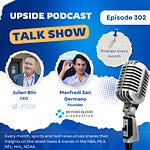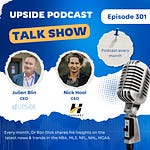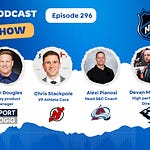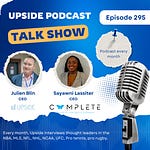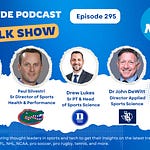This week, we have the honor to have Pete DeNagy, President of Acommence Advisors, and founder of IoT America. Pete is also the former GM of Samsung Enterprise.
📝Show Notes: Throughout this interview, we touched on Pete’s background, the biggest challenges when it comes to providing the best in stadium experience nowadays. We also talked about the capacity issues w WIFI and LTE. We also discussed what is available today and what will be available tomorrow (WIFI 6, 6G, etc.) to provide the best sports experience in stadium. Lastly we discussed the NFT/Metaverse space.
Best Quotes: Here are some of the key discussion points and best quotes from our conversation with Pete:
On his background:
“I have been in the communications mobile IoT and a wireless space for 40 years. So I've been around. In regard to that, here are some highlights of my experience. I ran the go to market strategy for the Americas for the IoT and mobile practice at Accenture. After that I worked as the GM of the United States for the enterprise business at Samsung. I led to the creation of Samsung Knox, which is the security protocol that's currently used on the Samsung devices. So I'm the father of Knox”.
“From there I ran the mobile and IoT solutions practice for the United States and Canada at Cap Gemini. After that I formed Acommence Advisors in 2013 as a consultancy where I provide the technology advisement and go to market advisement in the mobile space, and the IoT communities, and I am helping companies with business acceleration”.
“Some of the companies I've done consulting work for have included Comcast, Google, HTC, LG, Kyocera and others in the mobile space. Right now I'm doing some work for Ericsson. Also I founded in 2017 IoT America, which is an IoT sensor company providing connectivity for rural America, farmers, ranchers, and small towns. I have also spent four years on the partner board at Microsoft for windows mobile windows phone. I have spent time on the business working group and the fixed wireless route for the CBRS Alliance, which is a 5G wireless standard in the United States”.
On the biggest challenges when it comes to providing the best in-stadium experience nowadays:
“Airports, stadiums and ports all share the same endemic problem and that's density. They are hugely dense areas. So in a stadium, when you have 60,000, 80,000, to 100,000 people all trying to connect to the Wi-Fi or all trying to connect to the cellular, you need more and more access points, because what ends up happening is an access point will only handle so many connections. So this is what happens in a stadium and this is really frustrating”.
“And this was the same for Wi-Fi or for cellular networks where you connect to the Wi-Fi or the cellular network and then you you transmit data. And then you have to disconnect because somebody else is trying to get the Wi-Fi data and then you don't have service in your area any more. So in my case, in my example, I wasn't able to get on the internet because they don't have enough access points and enough radio frequencies”.
On what we have available today and what we're going to have in the future, starting with WIFI 6, WIFI 6E:
“So let's go to Wi-Fi first. So most people in their homes or in their offices, they have an older version of Wi-Fi called Wi-Fi. But a new iteration of Wi-Fi has come out called Wi-Fi 6. So Wi-Fi 6 has better utilization capabilities, better channel access provides more chip, and more connectivity channels per wireless router. And Wi-Fi 6 actually offers the first security protocol in 15 years. Basically now we offer the best security which is in the protocol and is called a web two and Wi-Fi 6. We now have web 3.0, which has a much higher level of encryption and capability in Wi-Fi”.
Additionally, the Wi-Fi 6E has the ability to backhaul the data between the access points. I can actually just plug them in, set them up and they could actually intercommunicate between each other to add capacity on an ad hoc basis. It is really good for a stadium event where you want to temporarily bring in additional capacity in different locations”.
On 5G:
“Technically 5G is nothing more than a software upgrade. So in the world of wireless, there is an organization that handles the cellular standard globally. And it's called the 3GPP. So 4G is release 14 of the 3GPP software rollout. It is released by the 3GPP. So it's a software upgrade, but to provide the capabilities, you also need to have a hardware upgrade to the radios. So the big difference between 4G and 5G or LTE is that 5G can go faster. 5G also has the ability to access the upper levels of radio frequency that were never able to be used before”.
“4G had the ability to concurrently connect between 5 and 10,000 devices at any given time, which is, again, adding to people’s frustration. But with 5G, they upped it exponentially. So you can go from 2000 concurrent connections to a million”.
“And the reason that they upped it to a million is because we actually don't think of all the connections. Because with IoT or the internet of things, you have multiple connections. So let's take the NFL. So we all look at those little funny stripes on jerseys. Well, they're actually IoT centers. And you look at all the sideline information and you look at all the bars and there are thousands of sensors on an American football field. The same thing happens in European football clubs where there are thousands of sensors that are in the stadium and that are not connected to cell phones, but they are connected and are providing data back for analytic review (..) Verizon has already claimed that they've wired up 80 stadiums in United States for 5G”.
On what is 6G:
“So cell phones came out in 1985. So back then that was 1G. So every eight to 10 years, we get a new G. So if you think of 5G when it came at the end of 2020, you're going to look at 6G coming out anywhere between 2027 and 23. That's when 6G is going to be deployed”.
“6G is going to introduce spectrums above 60 Gigahertz, and we're going to be using spectral fields that are just way, way up high, which is going to increase capacity. There'll be some issues with distance, of course, and the speeds will be very very fast. And the latency will be instantaneous. So the applications for that will be in sports with instant access to information, and some really high definition video”.
“We're talking about video definitions beyond 8k. We're going to be talking about 12K, 16K video definition. We're going to be talking about very fast analytics and some holographic images as well. AR will be greatly enhanced as we go up the speed chain and as we're gonna see some very fast speeds and some very good latencies”.
On his take on the NFT/Metaverse space:
“If I am going to sum up the metaverse, it's going to be the further melding of your digital existence with your physical existence. You're going to be talking about digital representations. Gartner has one of the best definitions of the matter. It involves gaming, digital assets and LP infrastructure. One thing that really hasn't come out yet is the transference of your digital presence between devices. So your digital presence will be available on your wearables, your phone, in your car, your home, and your workplace”.
“So the metaverse in a stadium is basically when you're in the stadium, and your digital presence will come with you. So you're going to have an experience that's going to be, even though you might be among the a hundred thousand people, you're going to have an experience tailored to you because of your metaverse presence”.
“I think that's where it's going to all wrap up because it's going to be a digital representation of your persona that will be interleaved with physical representations of your persona. That will not be restricted by location”.
“Let's say I met at a AT&T stadium in Dallas and I'm watching the Dallas Cowboys. So at that point I'm sitting in the stadium, but everything around me that I see is tailored to my preference. So that would be your digital persona being interleaved with your physical persona and the experience that I have in the stadium, even though I'm sitting in the stadium seat which is tailored
to my preferences. So they will know your preferences because of past behaviors. So when when the person comes around to get me a beer they'll know that I'm allergic to peanuts, so they won't give me peanuts. They won't offer me that. Or they might know that even though I'm at the AT&T stadium watching the Cowboys, I'm also a Philadelphia Eagles fan”.
“So as an Eagles fan, they will provide me my visual experience, statistics and analytics, more focused to my team as opposed to the other team, or they might go forward and provide customer ads, digital displays or digital signages in the stadium. Well, the digital signage in my physical representation and the stadium are actually tailored to my buying habits and they could show you some custom NFTs of your favorite teams”.
“The minority report is probably going to be the best movie representation of future capabilities that's ever been done. And I think we're going to have an exterior experience like the Minority report. That's going to be based on a metaverse interaction, and 5G and 6G and Wi-Fi 6 and soon to be Wi-Fi 7”.
“With 6G, if I was betting and if I had a fantasy team on Draft Kings, I would actually be able to look at the real time impact of the players on the field as they're aligned to my fantasy”.
You may also like:
⭐Sports Performance Roles & Best Practices (Head of Performance, Head Athletic Trainer..)
🔮 2022 Upside Top Sports Tech Predictions (NFT/Metaverse, Sports Performance, IPOs/M&As..)
🔗 🔥 Upside Analysis: NFTs Vs Crypto Vs Digital Currency, How Are They Different?
🔥 Upside Chat: Dave Hancock, CEO, Apollo (Leading Athlete Management Systems (AMS) vendor)
🔥Upside Chat: Alexi Pianosi, Strengths and Conditioning Coach, Pittsburgh Penguins (NHL)
🔥Upside Chat: Pierre Barrieu, High Performance Director, Toronto FC (MLS)




